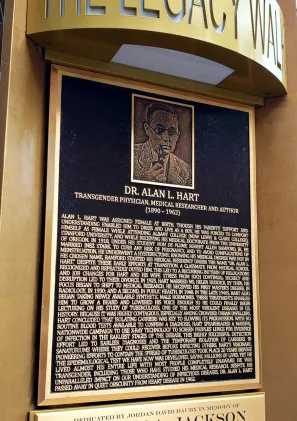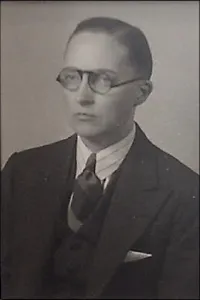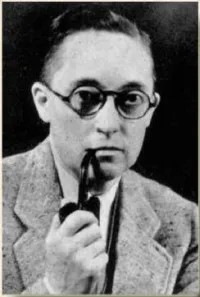Biography
1890 - 1962
"Each of us must take into account the raw material which heredity dealt us at birth and the opportunities we have had along the way, and then work out for ourselves a sensible evaluation of our personalities and accomplishments."
- Dr. Alan L. Hart
Alan L. Hart was assigned female at birth. Though his parents’ support and understanding enabled him to dress and live as a boy, he was forced to comport himself as female while attending Albany College (now Lewis & Clark College), Stanford University, and while receiving his medical doctorate from the University of Oregon. In 1918, under his student nom de plume, Robert Allen Bamford, Jr., he married Inez Stark. To curb any risk of pregnancy, and to avoid complications of menstruation, he underwent a hysterectomy. Knowing his medical degree was not in his chosen name, Bamford started his medical residency under the name Dr. Alan L. Hart. Despite these early efforts at transition, a classmate from medical school recognized and repeatedly outed him. This led to a recurring pattern of relocations and job changes for Hart and his wife. Stress from such continual secrecy and disruption led to their divorce. In 1925, Hart remarried Ms. Helen Ruddick. By then, his focus began to shift to medical research. He received his first Master’s Degree, in Radiology, in 1930; and a second, in Public Health, in 1948. In the late 1940s, Hart also began taking newly available synthetic male hormones. These treatments enabled him to grow a beard and lowered his voice enough so he could finally begin lecturing on his study of Tuberculosis, one of the most virulent diseases in U.S. History. Because it was highly contagious, especially among crowded urban dwellers, Hart concluded that isolating carriers was key to slowing its progression. With no routine blood tests available to confirm a diagnosis, Hart spearheaded a massive, nationwide campaign to use X‐Ray technology to screen peoples’ lungs for evidence of infection in the earliest stages of the disease. This highly successful detection effort led to earlier diagnoses and the temporary isolation of carriers in sanatoriums where they could recover before infecting others. Hart’s visionary, groundbreaking efforts to contain the spread of Tuberculosis took place 20 years before the epidemiological test we have now was developed, saving millions of lives. Yet he lived almost his entire life with most people completely unaware he was Transgender, including those who have studied his medical research. Despite his unparalleled impact on our understanding of infectious diseases, Dr. Alan L. Hart passed away in quiet obscurity from heart disease in 1962.
1890 - 1962
"Each of us must take into account the raw material which heredity dealt us at birth and the opportunities we have had along the way, and then work out for ourselves a sensible evaluation of our personalities and accomplishments."
- Dr. Alan L. Hart
Alan L. Hart was assigned female at birth. Though his parents’ support and understanding enabled him to dress and live as a boy, he was forced to comport himself as female while attending Albany College (now Lewis & Clark College), Stanford University, and while receiving his medical doctorate from the University of Oregon. In 1918, under his student nom de plume, Robert Allen Bamford, Jr., he married Inez Stark. To curb any risk of pregnancy, and to avoid complications of menstruation, he underwent a hysterectomy. Knowing his medical degree was not in his chosen name, Bamford started his medical residency under the name Dr. Alan L. Hart. Despite these early efforts at transition, a classmate from medical school recognized and repeatedly outed him. This led to a recurring pattern of relocations and job changes for Hart and his wife. Stress from such continual secrecy and disruption led to their divorce. In 1925, Hart remarried Ms. Helen Ruddick. By then, his focus began to shift to medical research. He received his first Master’s Degree, in Radiology, in 1930; and a second, in Public Health, in 1948. In the late 1940s, Hart also began taking newly available synthetic male hormones. These treatments enabled him to grow a beard and lowered his voice enough so he could finally begin lecturing on his study of Tuberculosis, one of the most virulent diseases in U.S. History. Because it was highly contagious, especially among crowded urban dwellers, Hart concluded that isolating carriers was key to slowing its progression. With no routine blood tests available to confirm a diagnosis, Hart spearheaded a massive, nationwide campaign to use X‐Ray technology to screen peoples’ lungs for evidence of infection in the earliest stages of the disease. This highly successful detection effort led to earlier diagnoses and the temporary isolation of carriers in sanatoriums where they could recover before infecting others. Hart’s visionary, groundbreaking efforts to contain the spread of Tuberculosis took place 20 years before the epidemiological test we have now was developed, saving millions of lives. Yet he lived almost his entire life with most people completely unaware he was Transgender, including those who have studied his medical research. Despite his unparalleled impact on our understanding of infectious diseases, Dr. Alan L. Hart passed away in quiet obscurity from heart disease in 1962.
Lesson Plan
Please login or register for an account to view this lesson plan.
Demography
Demography
Gender Male
Sexual Orientation Straight
Gender Identity Transgender
Ethnicity Caucasian/White
Faith Construct Protestant
Nations Affiliated United States
Era/Epoch Great Depression (1929-1939) Roaring Twenties (1920-1929)
Field(s) of Contribution
Author
Medicine
STEM & Medicine
US History
Commemorations & Honors
First Documented Man in the United States to Undergo Gender Confirmation Surgery
Alan L. and Edna Ruddick Hart Fund Created For Leukemia Research
Stanford University Exhibition on Hart's Life and Work (1994)
Lewis & Clark University Exhibition on Hart's Life and Work (2002)
Demography
Gender Male
Sexual Orientation Straight
Gender Identity Transgender
Ethnicity Caucasian/White
Faith Construct Protestant
Nations Affiliated United States
Era/Epoch Great Depression (1929-1939) Roaring Twenties (1920-1929)
Field(s) of Contribution
Author
Medicine
STEM & Medicine
US History
Commemorations & Honors
First Documented Man in the United States to Undergo Gender Confirmation Surgery
Alan L. and Edna Ruddick Hart Fund Created For Leukemia Research
Stanford University Exhibition on Hart's Life and Work (1994)
Lewis & Clark University Exhibition on Hart's Life and Work (2002)
Resources
Resources
http://www.oregonencyclopedia.org/articles/hart_alan_1890_1962_/
http://www.outhistory.org/exhibits/show/tgi-bios/alan-l-hart
http://digitalcollections.lclark.edu/collections/show/64
http://www.dailykos.com/story/2013/10/03/1243543/-LGBT-History-Month-Dr-Alan-L-Hart
https://www.encyclopedia.com/social-sciences/encyclopedias-almanacs-transcripts-and-maps/hart-alan-l
https://www.makingqueerhistory.com/articles/2017/5/21/alan-l-hart-part-1
https://www.makingqueerhistory.com/articles/2017/5/21/alan-l-hart-part-2
https://www.scientificamerican.com/article/trailblazing-transgender-doctor-saved-countless-lives/
Resources
http://www.oregonencyclopedia.org/articles/hart_alan_1890_1962_/
http://www.outhistory.org/exhibits/show/tgi-bios/alan-l-hart
http://digitalcollections.lclark.edu/collections/show/64
http://www.dailykos.com/story/2013/10/03/1243543/-LGBT-History-Month-Dr-Alan-L-Hart
https://www.encyclopedia.com/social-sciences/encyclopedias-almanacs-transcripts-and-maps/hart-alan-l
https://www.makingqueerhistory.com/articles/2017/5/21/alan-l-hart-part-1
https://www.makingqueerhistory.com/articles/2017/5/21/alan-l-hart-part-2
https://www.scientificamerican.com/article/trailblazing-transgender-doctor-saved-countless-lives/



